Hall and Ion-Slip Effect on CNTS Nanofluid over a Porous Extending Surface through Heat Generation and Absorption
Abstract
1. Introduction
2. Formulation of the Problem
3. Homotopy Analysis Solution
3.1. 0-th Order Set of System
3.2. jth-Order Deformation System
3.3. The Convergence of Homotopy Result
4. Results and Discussion
Table Discussion
5. Conclusions
Author Contributions
Funding
Acknowledgments
Conflicts of Interest
Nomenclature
| List of Symbols | Greek Symbols | ||
| , | Velocities components | Dynamic viscosity of nanofluid | |
| Magnetic field strength | Dynamic viscosity of base fluid | ||
| Dimensional velocity profiles | Nanofluid density | ||
| Fluid temperature | Base fluid density | ||
| Temperature of base fluid | Similarity variable. | ||
| Free surface temperature | Nanoparticle volume fraction | ||
| Magnetic parameter. | Dimensional heat profiles. | ||
| Heat transfer coefficient. | Electrical conductivity | ||
| Stretching parameter. | Electron cyclotron | ||
| Prandtl number. | Angular velocity | ||
| Biot number. | Porosity parameter | ||
| Eckert number. | Auxiliary constant | ||
| Nusselt number. | Subscripts | ||
| Skin friction coefficient | nf | Nanofluid | |
| Hall parameter | f | Base fluid | |
| Ion-slip parameter | Abbreviations | ||
| Stretching velocity | ODE | Ordinary differential equation | |
| Specific heat of base fluid | HAM | Homotopy Asymptotic Method | |
| MHD | Magneto-hydrodynamics | ||
| Thermal conductivity (). | SWCNT | Single wall carbon nanotube | |
| Heat generation/absorption parameter | MWCNT | Multi wall carbon nanotube | |
| Stefan Boltzmann constant. | MRA | Magnetic resonance angiography | |
| Absorption coefficient. | MRI | Magnetic resonance imaging | |
References
- Choi, S.U.S.; Eastman, J.A. Enhancing thermal conductivity of fluids with nanoparticles. In Proceedings of the ASME International Mechanical Engineering Congress and Exposition, San Francisco, CA, USA, 12–17 November 1995; pp. 99–105. [Google Scholar]
- Xiao, B.; Wang, W.; Zhang, X.; Long, G.; Fan, J.; Chen, H.; Deng, L. A novel fractal solution for permeability and Kozeny-Carman constant of fibrous porous media made up of solid particles and porous fibers. Powder Technol. 2019, 349, 92–98. [Google Scholar] [CrossRef]
- Liang, M.; Liu, Y.; Xiao, B.; Yang, S.; Wang, Z.; Han, H. An analytical model for the transverse permeability of gas diffusion layer with electrical double layer effects in proton exchange membrane fuel cells. Int. J. Hydrog. Energy 2018, 43, 17880–17888. [Google Scholar] [CrossRef]
- Long, G.; Liu, s.; Xu, G.; Wong, S.W.; Chen, H.; Xiao, B. A Perforation-Erosion Model for Hydraulic-Fracturing Applications. SPE Prod. Oper. 2018, 33, 770–783. [Google Scholar] [CrossRef]
- Xu, H.; Pop, I. Mixed convection flow of a nanofluid over a stretching surface with uniform free stream in the presence of both nanoparticles and gyrotactic microorganisms. Int. J. Heat Mass Tran. 2014, 75, 610–623. [Google Scholar] [CrossRef]
- Das, K.; Duari, P.R.; Kundu, P.K. Nanofluid flow over an unsteady stretching surface in presence of thermal radiation. Alex. Eng. J. 2014, 53, 737–745. [Google Scholar] [CrossRef]
- Nadeem, S.; Haq, R.U.; Khan, Z.H. Heat transfer analysis of water-based nanofluid over an exponentially stretching sheet. Alex. Eng. J. 2014, 53, 219–224. [Google Scholar] [CrossRef]
- Ramesh, G.K.; Gireesha, B.J. Influence of heat source/sink on a Maxwell fluid over a stretching surface with convective boundary condition in the presence of nanoparticles. Ain Shams Eng. J. 2014, 5, 991–998. [Google Scholar] [CrossRef]
- Ellahi, R.; Hassan, M.; Zeeshan, A. Shape effects of nanosize particles in Cu-H2O nanofluid on entropy generation. Int. J. Heat Mass Trans. 2015, 81, 449–456. [Google Scholar] [CrossRef]
- Sheikholeslami, M.; Ellahi, R. Electro-hydrodynamic nanofluid hydrothermal treatment in an enclosure with sinusoidal upper wall. Appl. Sci. 2015, 5, 294–306. [Google Scholar] [CrossRef]
- Khan, M.; Khan, W.A.; Alshomrani, A.S. Non-linear radiative flow of three dimensional Burgers nanofluid with new mass flux effect. Int. J. Heat Mass Trans. 2016, 10, 570–576. [Google Scholar] [CrossRef]
- Abdelmeguid, M.S. The Effect of Thermophoresis on Boundary-Layer Flow of a Nanofluid Over Stretching Sheet. J. Nanofluids 2018, 7, 210–222. [Google Scholar] [CrossRef]
- Yanala, R.D.; Rao, S.V.; Babu, L.A. MHD Boundary Layer Flow of Nanofluid and Heat Transfer Over a Nonlinear Stretching Sheet with Chemical Reaction and Suction/Blowing. Int. J. Math. Trends Tech. 2018, 7, 404–412. [Google Scholar]
- Iijim, S. Helical microtubules of graphitic carbon. Nature 1991, 354, 56–58. [Google Scholar] [CrossRef]
- Haq, R.U.; Nadeem, S.; Khan, Z.H.; Noor, N.F.M. Convective heat transfer in MHD slip flow over a stretching surface in the presence of carbon nanotubes. Physica B 2015, 457, 40–47. [Google Scholar] [CrossRef]
- Mahanthesh, B.; Gireesha, B.J.; Shashikumar, N.S.; Shehzad, S.A. Marangoni convective MHD flow of SWCNT and MWCNT nanoliquids due to a disk with solar radiation and irregular heat source. Physica E 2017, 94, 25–30. [Google Scholar] [CrossRef]
- Hayat, T.; Kiran, A.; Imtiaz, M.; Alsaedi, A. Unsteady flow of carbon nanotubes with chemical reaction and Cattaneo-Christov heat flux model. Results Phys. 2017, 7, 823–831. [Google Scholar] [CrossRef]
- Sreedevi, P.; Reddy, P.S.; Chamkha, A.J. Magneto-hydrodynamics heat and mass transfer analysis of single and multi-wall carbon nanotubes over vertical cone with convective boundary condition. Int. J. Mech. Sci. 2018, 135, 646–655. [Google Scholar] [CrossRef]
- Jyothi, K.; Reddy, P.S.; Reddy, M.S. Influence of Magnetic field and Thermal radiation on convective flow of SWCNTs-water and MWCNTs-water nanofluid between rotating stretchable disks with convective boundary conditions. Powder Tech. 2018, 331, 326–337. [Google Scholar] [CrossRef]
- Nasir, S.; Islam, S.; Gul, T.; Shah, Z.; Khan, M.A.; Khan, W.; Khan, A.Z.; Khan, S. Three-dimensional rotating flow of MHD single wall carbon nanotubes over a stretching sheet in presence of thermal radiation. Appl. Nanosci. 2018, 8, 1361–1378. [Google Scholar] [CrossRef]
- Nasir, S.; Shah, Z.; Islam, S.; Khan, W.; Bonyah, E.; Ayaz, M.; Khan, A. Three dimensional Darcy-Forchheimer radiated flow of single and multiwall carbon nanotubes over a rotating stretchable disk with convective heat generation and absorption. AIP Adv. 2019, 9, 1–17. [Google Scholar] [CrossRef]
- Alsagri, A.S.; Nasir, S.; Gul, T.; Islam, S.; Nisar, K.S.; Shah, Z.; Khan, I. MHD Thin Film Flow and Thermal Analysis of Blood with CNTs Nanofluid. Coatings 2019, 9, 175. [Google Scholar] [CrossRef]
- Asadi, A.; Asadi, M.; Rezaniakolaei, A.; Rosendahl, L.A.; Wongwises, S. An experimental and theoretical investigation on heat transfer capability of Mg (OH)2/MWCNT-engine oil hybrid nano-lubricant adopted as a coolant and lubricant fluid. Appl. Therm. Eng. 2018, 129, 577–586. [Google Scholar] [CrossRef]
- Asadi, A.; Alarifi, I.M.; Ali, V.; Nguyen, H.M. An experimental investigation on the effects of ultrasonication time on stability and thermal conductivity of MWCNT-water nanofluid: Finding the optimum ultrasonication time. Ultrason. Sonochem. 2019, 58, 1–8. [Google Scholar] [CrossRef]
- Tani, I. Steady flow of conducting fluids in channels under transverse magnetic fields with consideration of Hall effects. J. Aerospace Sci. 1962, 29, 297–305. [Google Scholar] [CrossRef]
- Hayat, T.; Shafique, M.; Tanveer, A.; Alsaedi, A. Hall and ion slip effects on peristaltic flow of Jeffrey nanofluid with Joule heating. J. Mag. Mag. Mater. 2016, 407, 51–59. [Google Scholar] [CrossRef]
- Srinivasacharya, D.; Shafeeurrahman, M. Hall and ion slip effects on mixed convection flow of nanofluid between two concentric cylinders. J. Assoc. Arab Univ. Basic Appl. Sci. 2017, 24, 223–231. [Google Scholar] [CrossRef]
- Su, X. Hall and ion-slip effects on the unsteady MHD mixed convection of Cu-water. Indian J. Pure Appl. Phys. 2017, 55, 564–573. [Google Scholar]
- Bilal, M.; Hussain, S.; Sagheer, M. Boundary layer flow of magneto-micropolar nanofluid flow with Hall and ion-slip effects using variable thermal diffusivity. Bull. Pol. Acad. Sci. Tech. Sci. 2017, 65, 383–390. [Google Scholar] [CrossRef]
- Shah, Z.; Dawar, A.; Alzahrani, E.; Kumam, P.; Khan, A.J.; Islam, S. Hall Effect on Couple Stress 3D Nanofluid Flow Over an Exponentially Stretched Surface With Cattaneo Christov Heat Flux Model. IEEE Access 2019, 7, 64844–64855. [Google Scholar] [CrossRef]
- Shah, Z.; Islam, S.; Gul, T.; Bonyah, E.; Khan, M.A. The electrical MHD and hall current impact on micropolar nanofluid flow between rotating parallel plates. Results Phys. 2018, 9, 1201–1214. [Google Scholar] [CrossRef]
- Ellahi, R.; Hassan, M.; Zeeshan, A.; Ambeen, A.K. The shape effects of nanoparticles suspended in HFE-7100 over wedge with entropy generation and mixed convection. Appl. Nanosci. 2016, 6, 641–651. [Google Scholar] [CrossRef]
- Ellahi, R.; Hassan, M.; Zeeshan, A. Aggregation effects on water base Al2O3-nanofluid over permeable wedge in mixed convection. Asia Pac. J. Chem. Eng. 2016, 11, 179–186. [Google Scholar] [CrossRef]
- Asadi, M. A guideline towards easing the decision-making process in selecting an effective nanofluid as a heat transfer fluid. Energy Convers. Manag. 2018, 175, 1–10. [Google Scholar] [CrossRef]
- Liang, M.; Fu, C.; Xiao, B.; Luo, L.; Wang, Z. A fractal study for the effective electrolyte diffusion through charged porous media. Int. J. Heat Mass Transf. 2019, 137, 365–371. [Google Scholar] [CrossRef]
- Yang, Y.H.; Li, M.X.; Zhou, W.X.; Stanley, H.E. Non-poisson donation behaviors in virtual worlds. arXiv 2019, arXiv:1902.06069. [Google Scholar] [CrossRef]
- Mebarek-Oudina, F. Convective heat transfer of Titania nanofluids of different base fluids in cylindrical annulus with discrete heat source. Heat Tran. Asian Res. 2019, 48, 135–147. [Google Scholar] [CrossRef]
- Mebarek-Oudina, F.; Bessaih, R. Oscillatory Magnetohydrodynamic Natural Convection of Liquid Metal between Vertical Coaxial Cylinders. J. Appl. Fluid Mech. 2016, 9, 1655–1665. [Google Scholar] [CrossRef]
- Wei, Y.; Wang, Z.; Qian, Y.; Guo, W. Study on Bifurcation and Dual Solutions in Natural Convection in a Horizontal Annulus with Rotating Inner Cylinder Using Thermal Immersed Boundary-Lattice Boltzmann Method. Entropy 2018, 20, 733. [Google Scholar] [CrossRef]
- Wei, Y.; Yang, H.; Lin, Z.; Wang, Z.; Qian, Y. A novel two-dimensional coupled lattice Boltzmann model for thermal incompressible flows. Appl. Math. Comput. 2018, 339, 556–567. [Google Scholar] [CrossRef]
- Wei, Y.; Wang, Z.; Qian, Y. A Numerical Study on Entropy Generation in Two-Dimensional Rayleigh-B´enard Convection at Different Prandtl Number. Entropy 2017, 19, 443. [Google Scholar] [CrossRef]
- Wei, Y.; Wang, Z.; Dou, S.; Qian, Y.; Yan, W. Simulations of natural convection heat transfer in an enclosure at different Rayleigh number using lattice Boltzmann method. Comput. Fluids 2016, 124, 30–38. [Google Scholar] [CrossRef]
- Wei, Y.; Wang, Z.; Yang, J.; Dou, H.; Qian, Y. A simple lattice Boltzmann model for turbulence Rayleigh-Benard thermal convection. Comput. Fluids 2015, 118, 167–171. [Google Scholar] [CrossRef]
- Wei, Y.; Wang, Z.; Dou, H.; Qian, Y. A novel two-dimensional coupled lattice Boltzmann model for incompressible flow in application of turbulence Rayleigh-Taylor instability. Comput. Fluids 2017, 156, 97–102. [Google Scholar] [CrossRef]
- Yang, H.; Wei, Y.; Zhu, Z.; Qian, Y. Statistics of Heat Transfer in Two-Dimensional Turbulent Rayleigh-Bénard Convection at Various Prandtl Number. Entropy 2018, 20, 582. [Google Scholar] [CrossRef]
- Wang, Z.; Wei, Y.; Qian, Y. Numerical study on entropy generation in thermal convection with differentially discrete heat boundary conditions. Entropy 2018, 20, 351. [Google Scholar] [CrossRef]
- Liao, S.J. On the homotopy analysis method for nonlinear problems. Appl. Math. Comput. 2007, 147, 499–513. [Google Scholar] [CrossRef]
- Dawar, A.; Shah, Z.; Khan, W.; Islam, S.; Idrees, M. An optimal analysis for Darcy-Forchheimer 3D Williamson Nanofluid Flow over a stretching surface with convective conditions. Adv. Mech. Eng. 2019, 11, 1–15. [Google Scholar] [CrossRef]
- Shah, Z.; Dawar, A.; Islam, S.; Khan, I.; Ching, D.L.C. Darcy-Forchheimer flow of radiative carbon nanotubes with microstructure and inertial characteristics in the rotating frame. Case Stud. Therm. Eng. 2018, 12, 823–832. [Google Scholar] [CrossRef]
- Khan, A.; Shah, Z.; Islam, S.; Dawar, A.; Bonyah, E.; Ullah, H.; Khan, A. Darcy-Forchheimer flow of MHD CNTs nanofluid radiative thermal behaviour and convective non uniform heat source/sink in the rotating frame with microstructure and inertial characteristics. AIP Adv. 2018, 8, 125024. [Google Scholar] [CrossRef]
- Shah, Z.; Dawar, A.; Kumam, P.; Khan, W.; Islam, S. Impact of Nonlinear Thermal Radiation on MHD Nanofluid Thin Film Flow over a Horizontally Rotating Disk. Appl. Sci. 2019, 9, 1533. [Google Scholar] [CrossRef]
- Khan, A.S.; Nie, Y.; Shah, Z.; Dawar, A.; Khan, W.; Islam, S. Three-Dimensional Nanofluid Flow with Heat and Mass Transfer Analysis over a Linear Stretching Surface with Convective Boundary Conditions. Appl. Sci. 2018, 8, 2244. [Google Scholar] [CrossRef]
- Shah, Z.; Islam, S.; Gul, T.; Bonyah, E.; Khan, M.A. Three dimensional third grade nanofluid flow in a rotating system between parallel plates with Brownian motion and thermophoresis effects. Results Phys. 2018, 10, 36–45. [Google Scholar] [CrossRef]
- Dawar, A.; Shah, Z.; Kumam, P.; Khan, W.; Islam, S. Influence of MHD on Thermal Behavior of Darcy-Forchheimer Nanofluid Thin Film Flow over a Nonlinear Stretching Disc. Coatings 2019, 9, 446. [Google Scholar] [CrossRef]
- Khan, N.S.; Gul, T.; Kumam, P.; Shah, Z.; Islam, S.; Khan, W.; Zuhra, S.; Sohail, A. Influence of Inclined Magnetic Field on Carreau Nanoliquid Thin Film Flow and Heat Transfer with Graphene Nanoparticles. Energies 2019, 12, 1459. [Google Scholar] [CrossRef]
- Ullah, A.; Alzahrani, E.O.; Shah, Z.; Ayaz, M.; Islam, S. Nanofluids Thin Film Flow of Reiner-Philippoff Fluid over an Unstable Stretching Surface with Brownian Motion and Thermophoresis Effects. Coatings 2019, 9, 21. [Google Scholar] [CrossRef]
- Khan, A.S.; Nie, Y.; Shah, Z. Impact of Thermal Radiation on Magnetohydrodynamic Unsteady Thin Film Flow of Sisko Fluid over a Stretching Surface. Processes 2019, 7, 369. [Google Scholar] [CrossRef]
- Saeed, A.; Zahir, S.; Islam, S.; Jawad, M.; Ullah, A.; Gul, T.; Kumam, P. Three-Dimensional Casson Nanofluid Thin Film Flow over an Inclined Rotating Disk with the Impact of Heat Generation/Consumption and Thermal Radiation. Coatings 2019, 9, 248. [Google Scholar] [CrossRef]
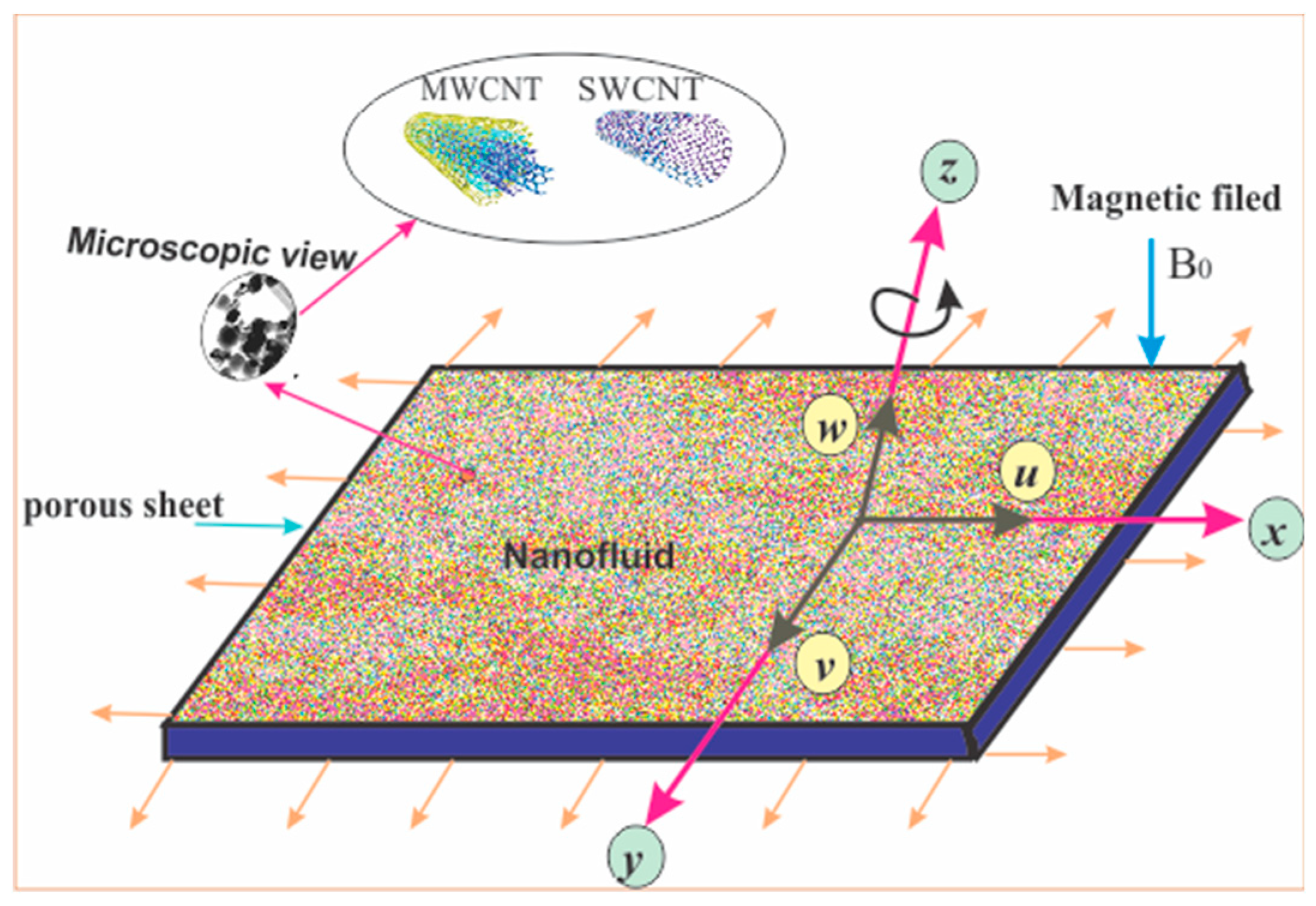
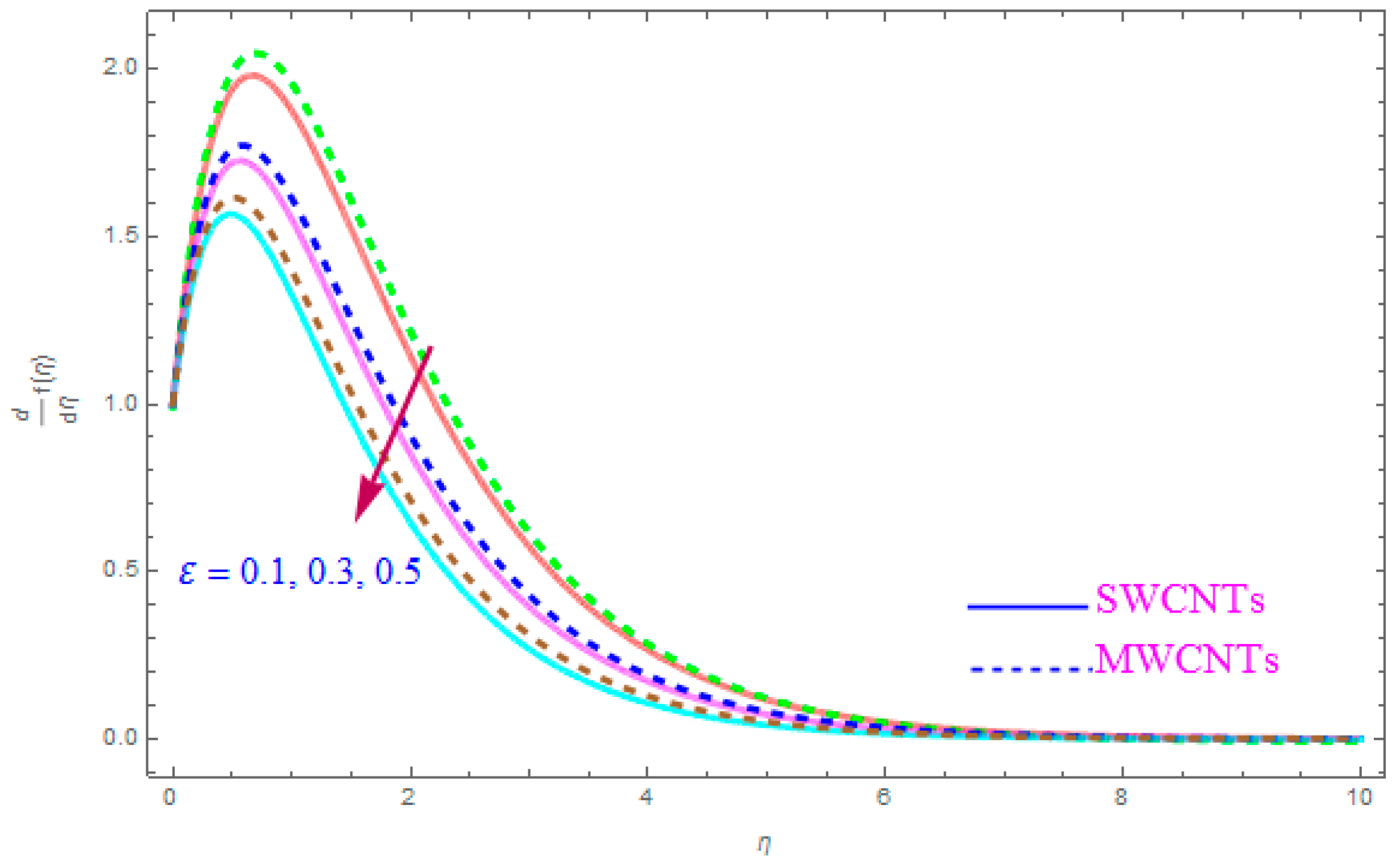
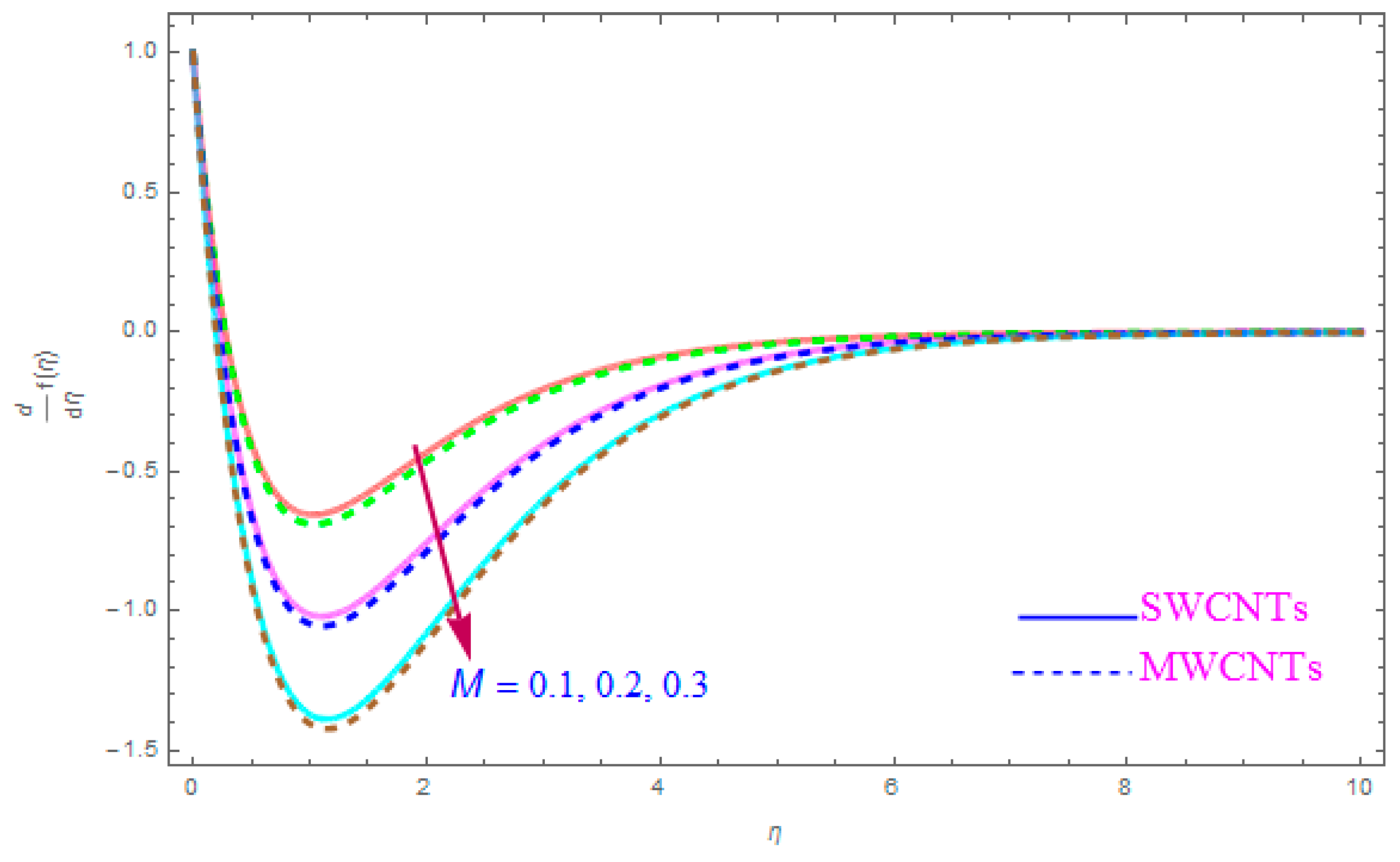
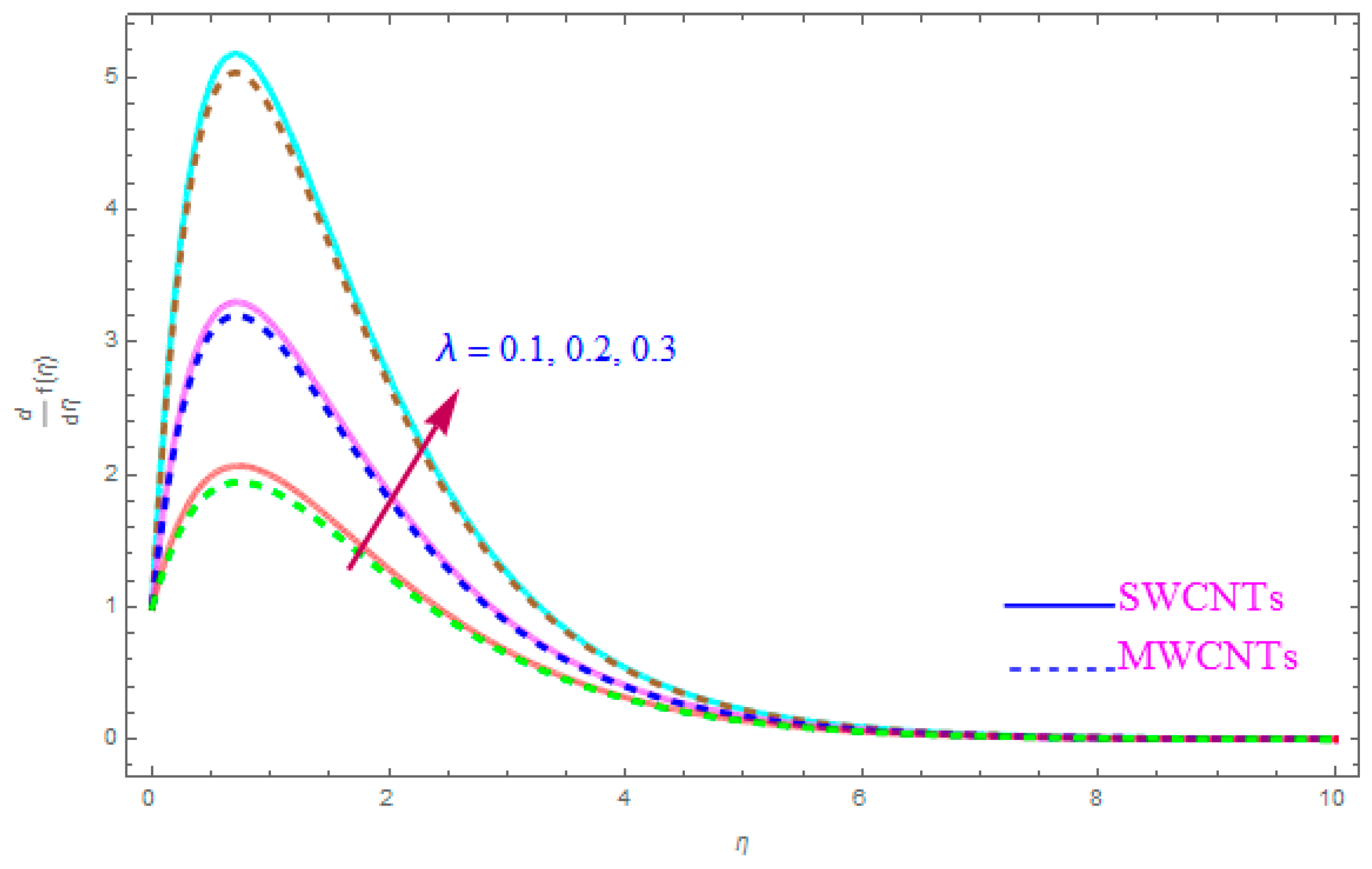
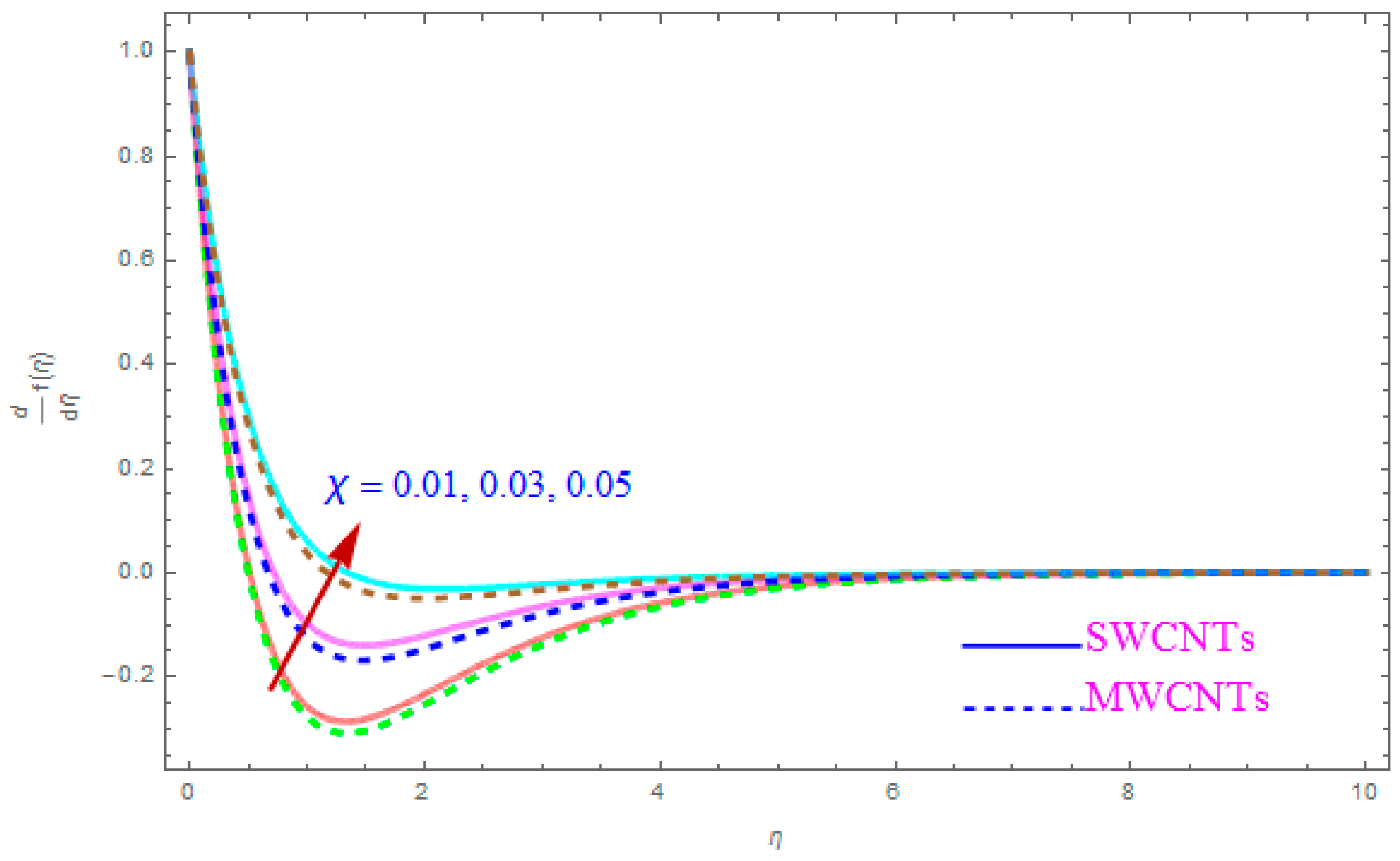
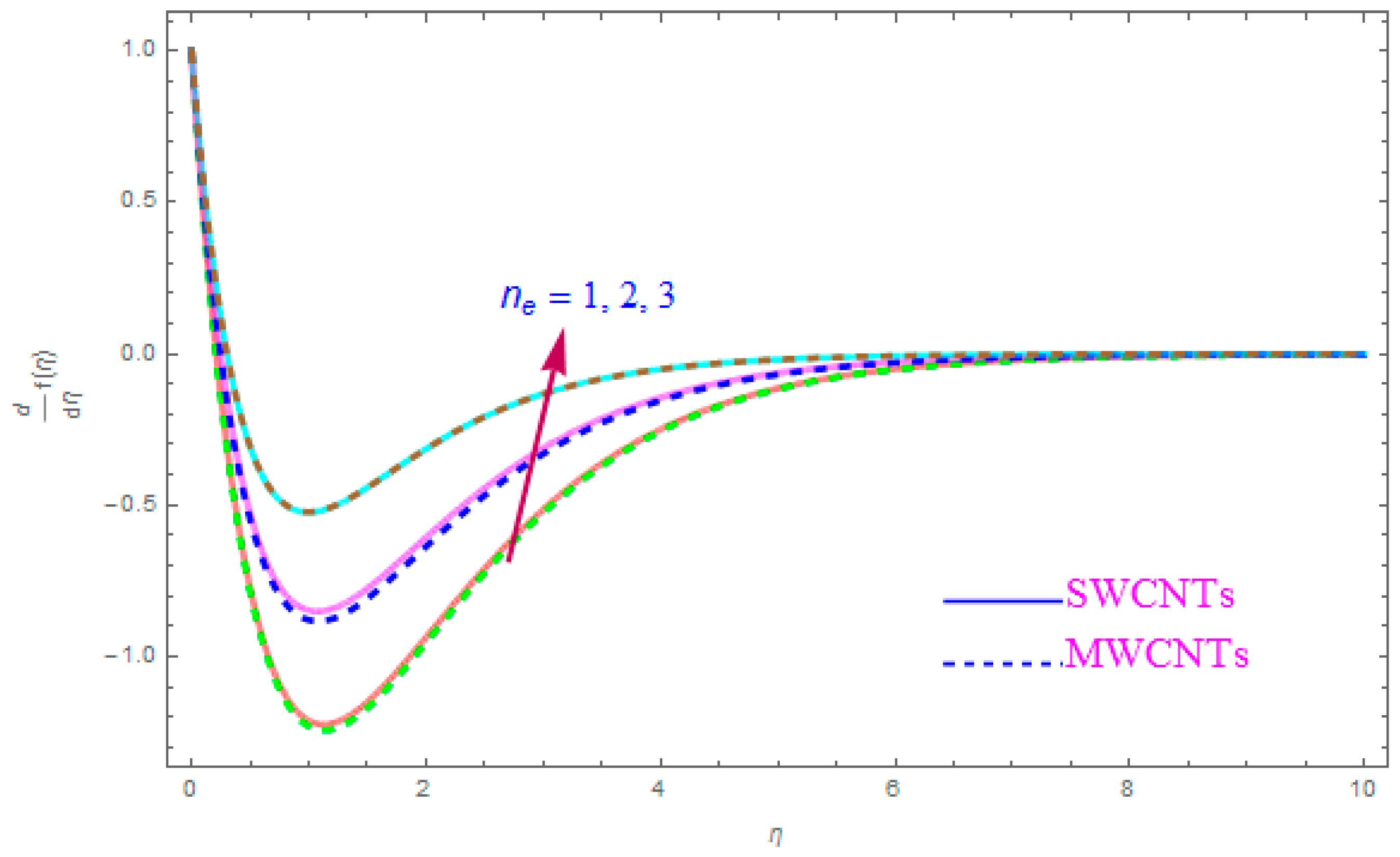
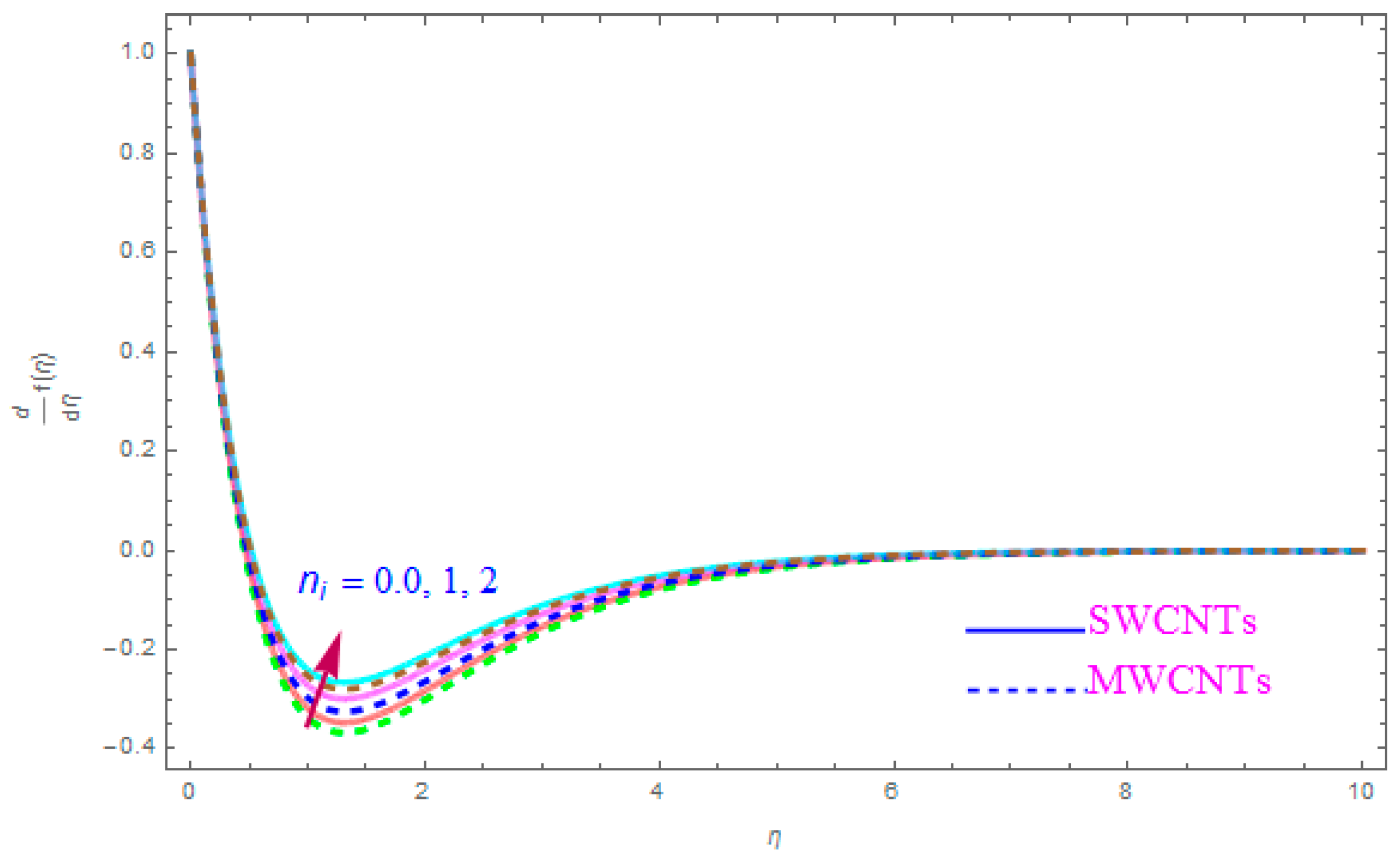
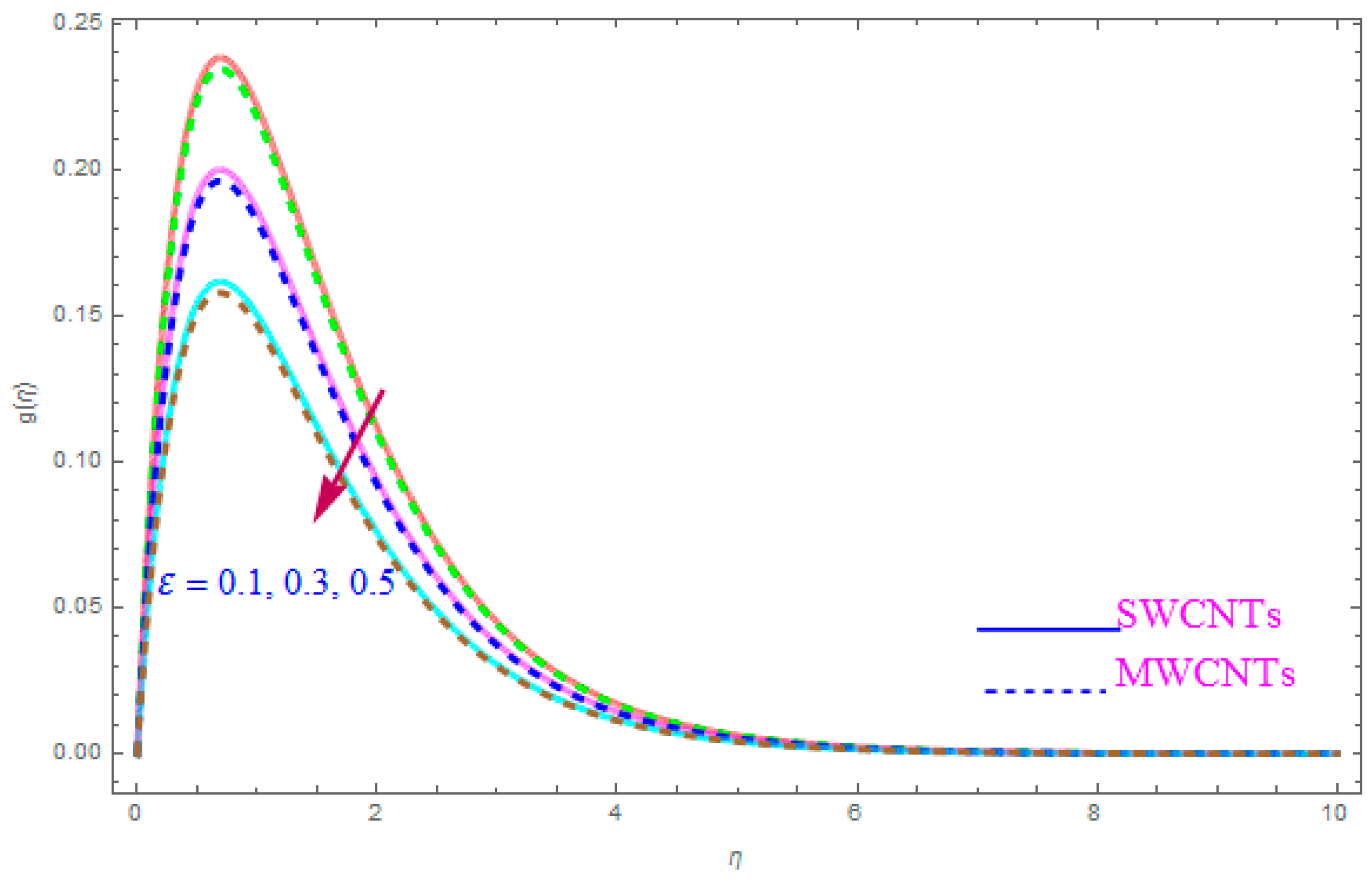
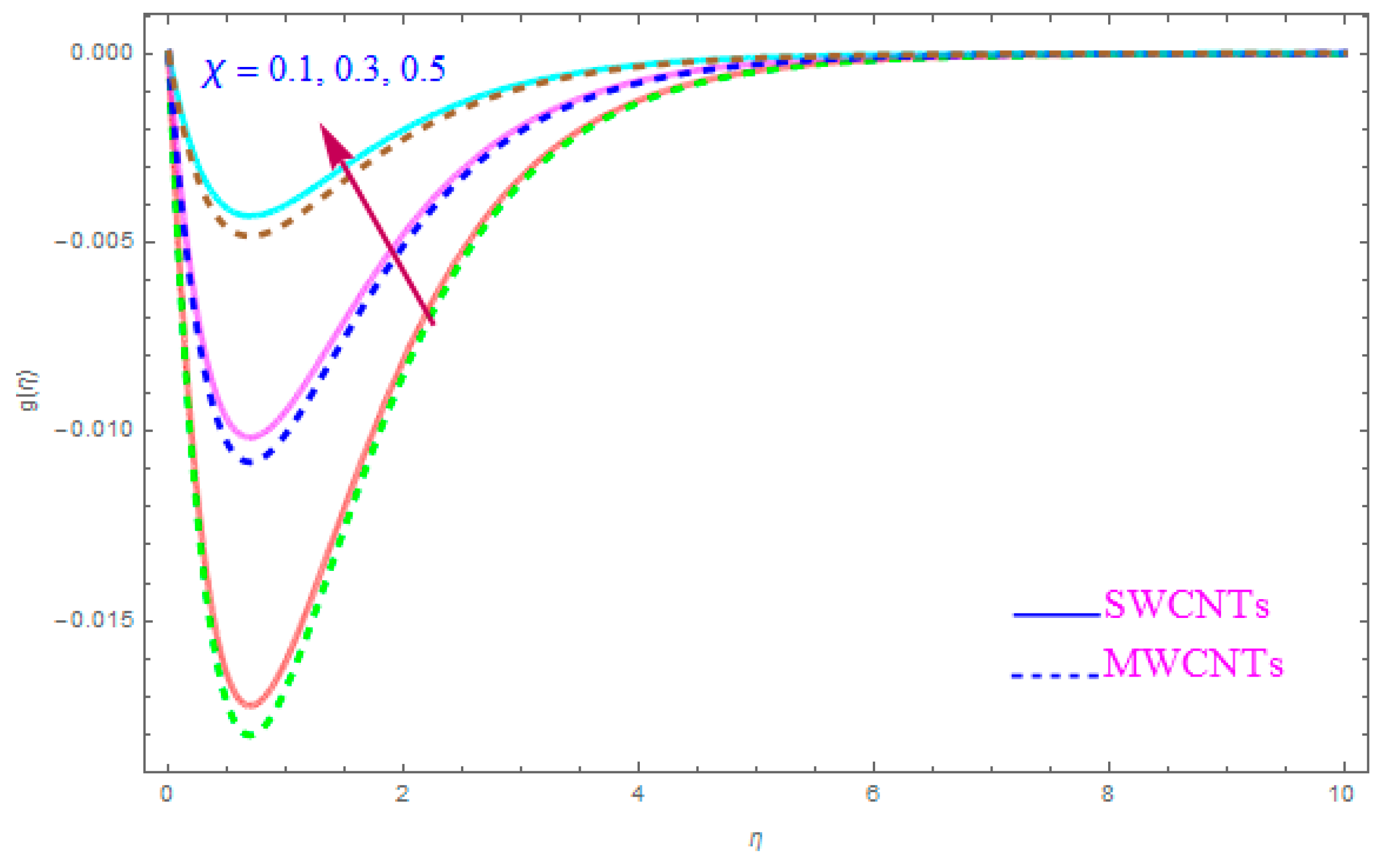
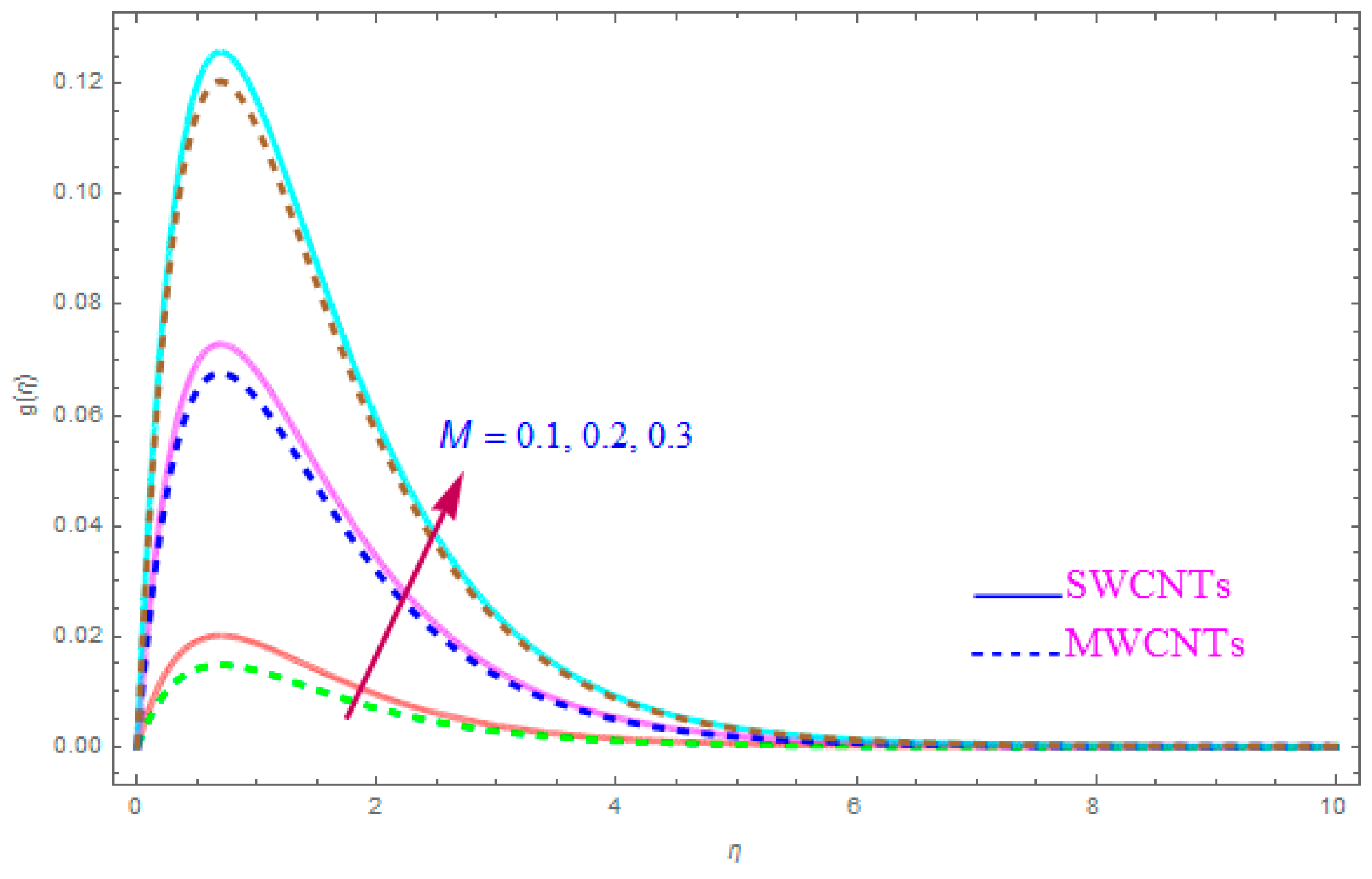
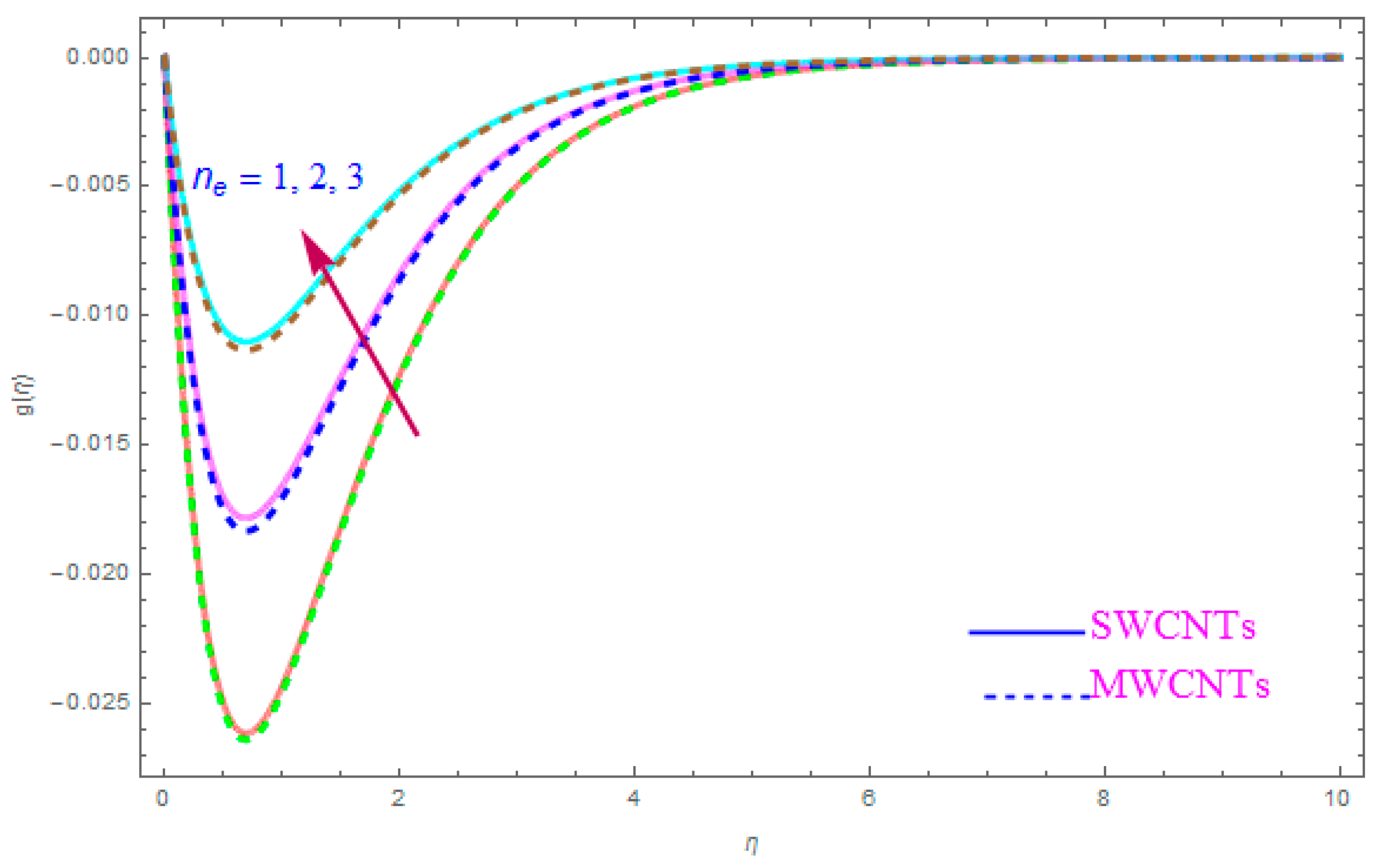
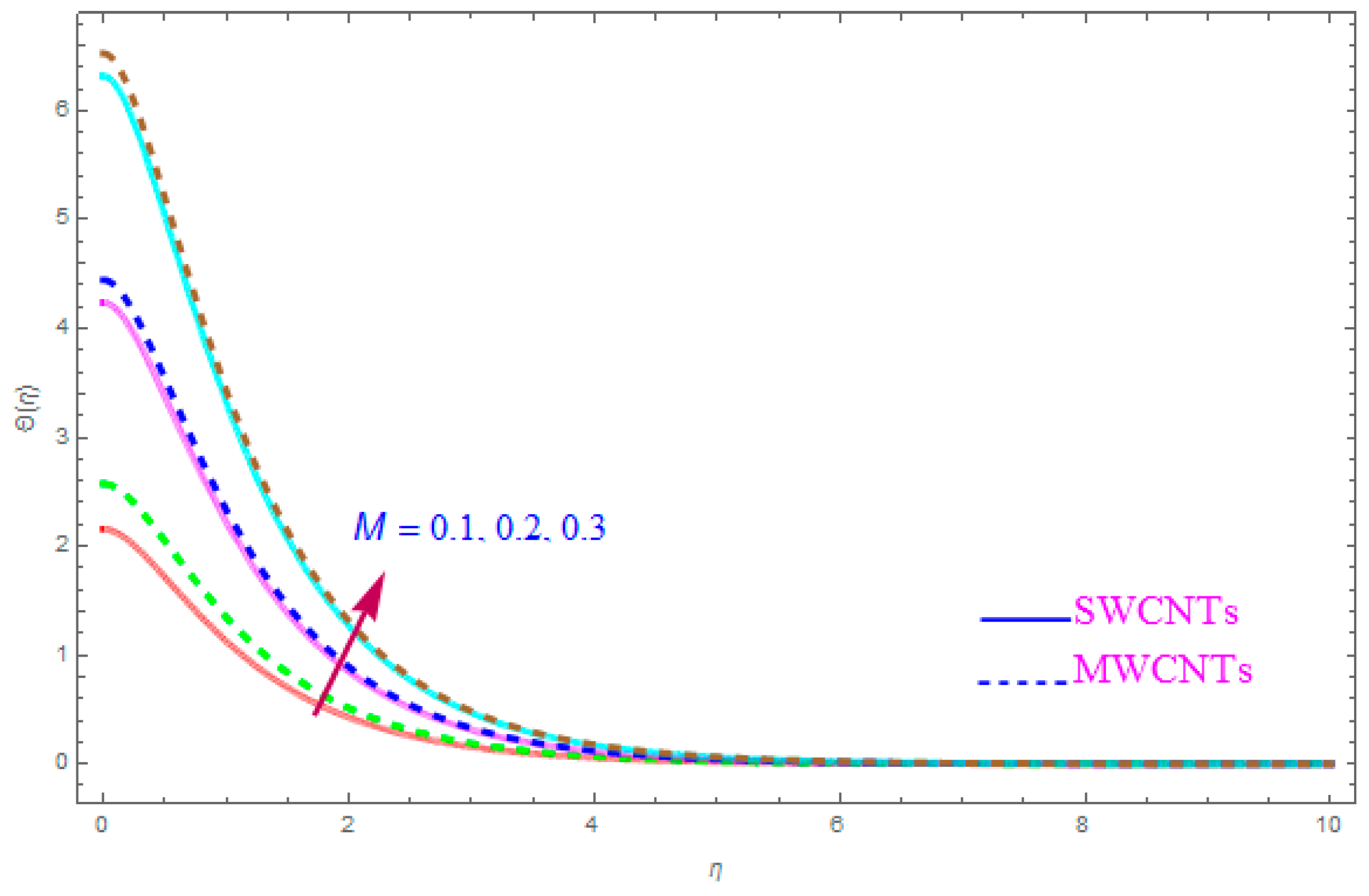
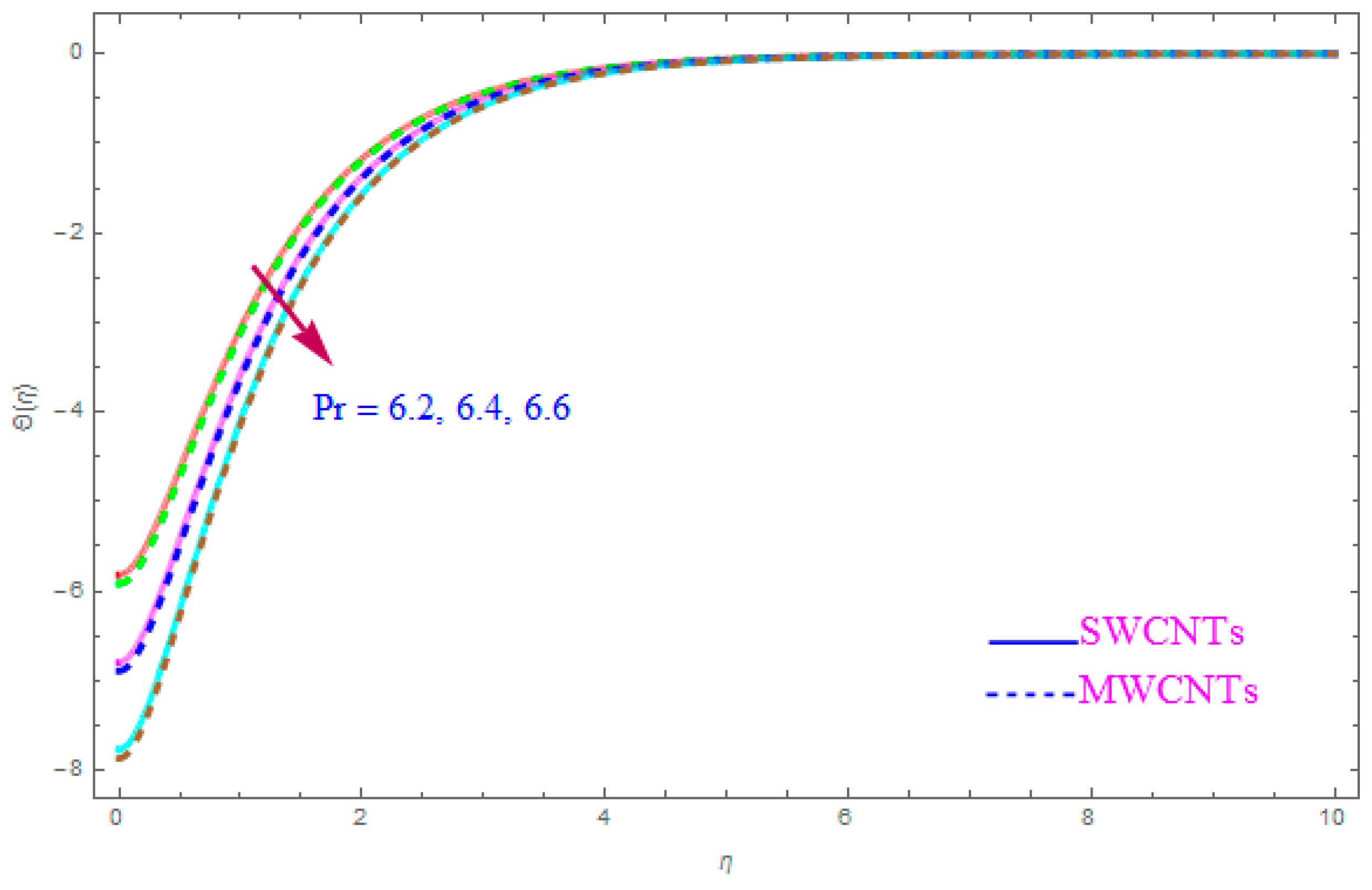
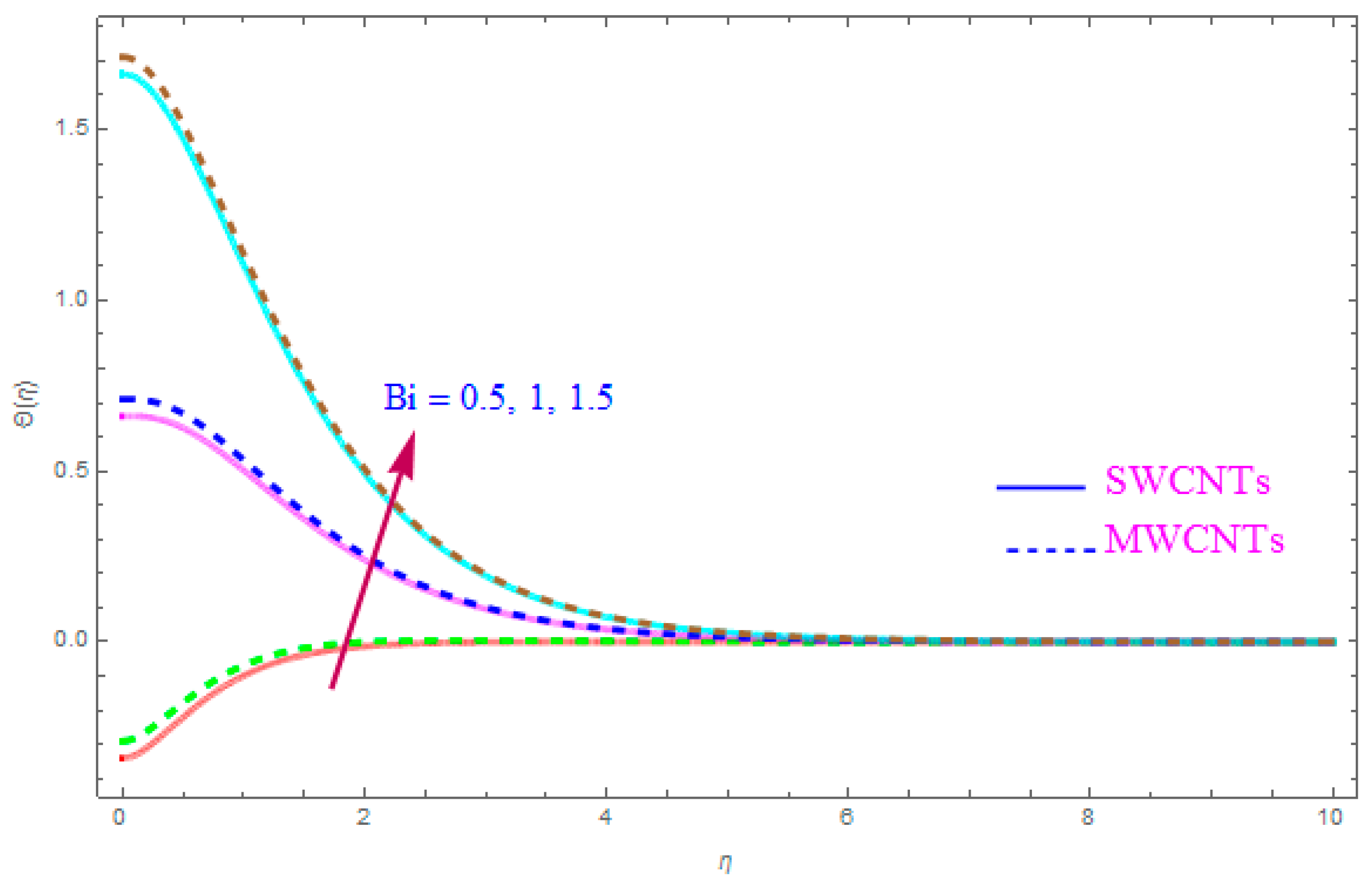

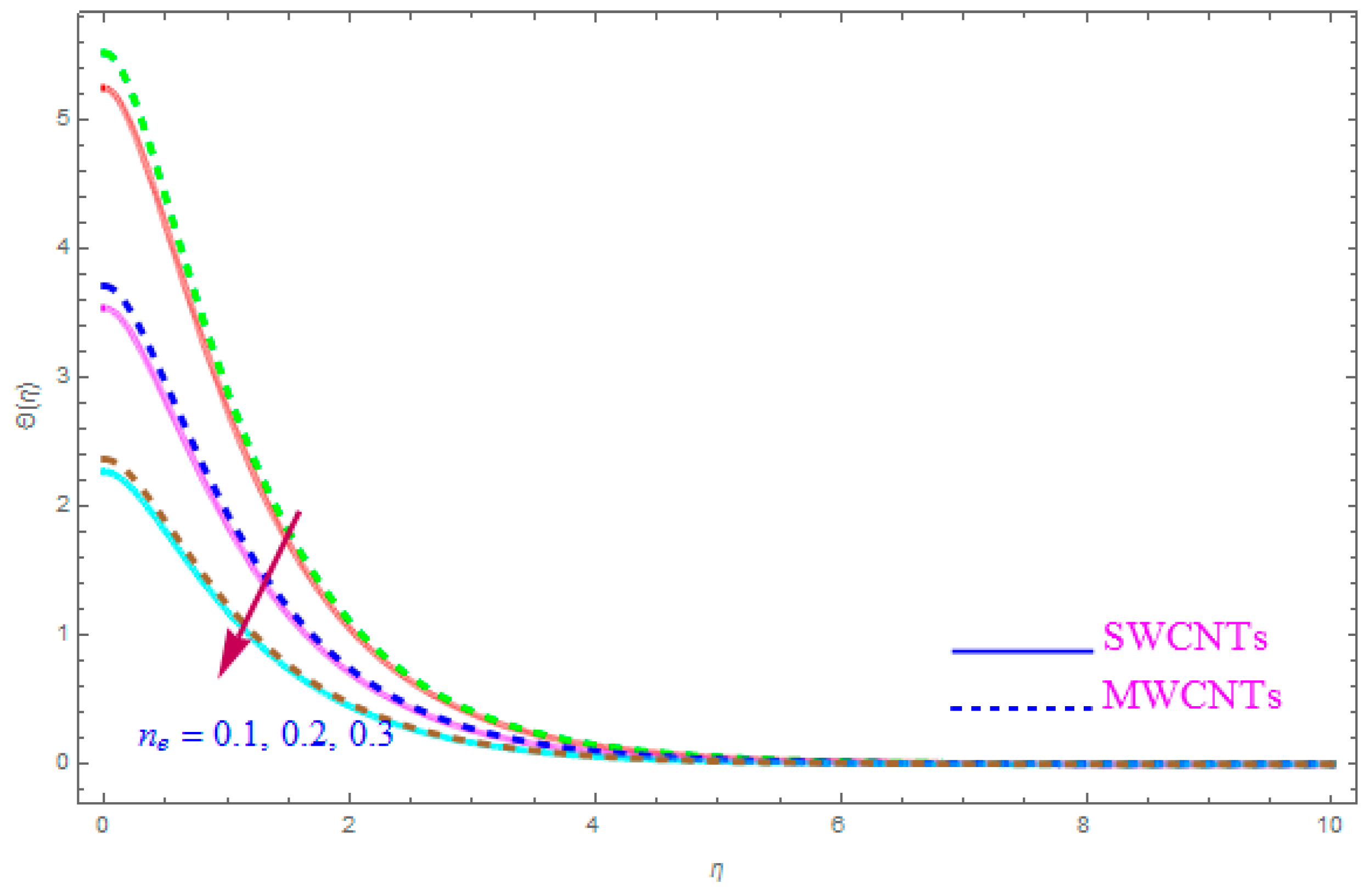

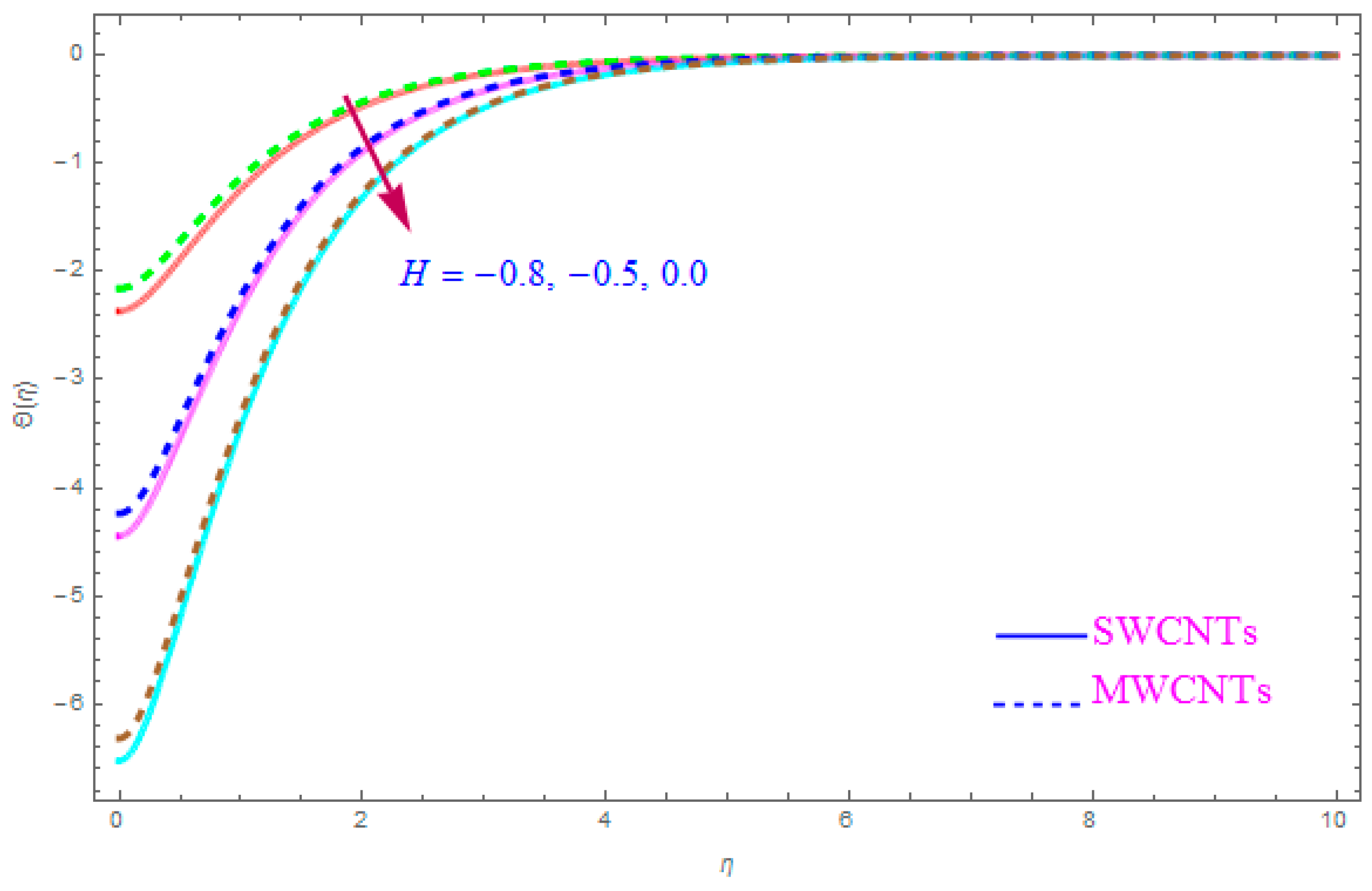
| Physical Properties | Base Liquid | Nanosize Particles | |
|---|---|---|---|
| Kerosene Oil | SWCNT | MWCNT | |
| 783 | 2600 | 1600 | |
| 2090 | 425 | 796 | |
| 0.145 | 6600 | 3000 | |
| Order of Approximations | SWCNTs-Kerosene | MWCNTs-Kerosene | ||||
|---|---|---|---|---|---|---|
| 1 | 0.36550 | 0.19234 | 0.6847 | 0.29470 | 0.18531 | 0.50562 |
| 5 | 0.32521 | 0.19123 | 0.4667 | 0.25210 | 0.18323 | 0.39435 |
| 10 | 0.31063 | 0.18723 | 0.4023 | 0.24320 | 0.18103 | 0.36716 |
| 15 | 0.30217 | 0.18214 | 0.3931 | 0.23230 | 0.17214 | 0.33958 |
| 18 | 0.20132 | 0.18213 | 0.2299 | 0.12905 | 0.17202 | 0.30210 |
| SWCNT | MWCNT | SWCNT | MWCNT | ||||||
|---|---|---|---|---|---|---|---|---|---|
| 0.1 | 0.2 | 0.5 | 0.2 | 0.1 | 0.1 | −1.93809 | −1.90481 | 0.329385 | 0.30179 |
| 0.2 | −2.34557 | −2.23450 | 0.284000 | 0.221342 | |||||
| 0.3 | −2.86236 | −2.74537 | 0.218497 | 0.20041 | |||||
| 0.1 | 0.2 | −1.93809 | −1.90152 | 0.329385 | 0.31191 | ||||
| 0.3 | −1.93809 | −1.91145 | 0.329385 | 0.31192 | |||||
| 0.4 | −1.93809 | −1.91245 | 0.329385 | 0.31193 | |||||
| 0.2 | 0.5 | −1.93809 | −1.80341 | 0.329385 | 0.31193 | ||||
| 0.6 | −1.97461 | −1.92340 | 0.404418 | 0.39832 | |||||
| 0.7 | −2.00896 | −1.98921 | 0.476478 | 0.39241 | |||||
| 0.5 | 0.2 | −1.93809 | −1.90452 | 0.329385 | 0.30171 | ||||
| 0.3 | −1.94134 | −1.92345 | 0.285883 | 0.27343 | |||||
| 0.4 | −1.94413 | −1.93532 | 0.242621 | 0.20129 | |||||
| 0.1 | −1.93809 | −1.87231 | 0.329385 | 0.29817 | |||||
| 0.2 | −1.90602 | −1.85342 | 0.381362 | 0.31242 | |||||
| 0.3 | −1.86140 | −1.83425 | 0.395883 | 0.35241 | |||||
| 0.1 | 0.1 | −1.93809 | −1.83425 | 0.329385 | 0.30123 | ||||
| 0.2 | −1.80716 | −1.63420 | 0.261963 | 0.24231 | |||||
| 0.3 | −1.76420 | −1.53421 | 0.177045 | 0.21611 | |||||
| SWCNT | MWCNT | ||||
|---|---|---|---|---|---|
| 0.3 | 6.4 | 0.2 | 0.2 | −0.0277452 | −0.0240453 |
| 0.4 | −0.0251504 | −0.0221502 | |||
| 0.5 | −0.0225163 | −0.0155167 | |||
| 0.3 | 6.4 | −0.0277452 | −0.0257453 | ||
| 6.6 | −0.0138570 | −0.0128575 | |||
| 6.8 | −0.00001796 | −0.0001179 | |||
| 6.4 | 0.2 | −0.0277452 | −0.0167453 | ||
| 0.3 | −0.0210052 | −0.0134055 | |||
| 0.4 | −0.0697556 | −0.0397554 | |||
| 0.2 | 0.2 | −0.0277452 | −0.0247454 | ||
| 0.3 | −0.0268688 | −0.0230681 | |||
| 0.4 | −0.0259934 | −0.0220934 | |||
© 2019 by the authors. Licensee MDPI, Basel, Switzerland. This article is an open access article distributed under the terms and conditions of the Creative Commons Attribution (CC BY) license (http://creativecommons.org/licenses/by/4.0/).
Share and Cite
Ameen, I.; Shah, Z.; Islam, S.; Nasir, S.; Khan, W.; Kumam, P.; Thounthong, P. Hall and Ion-Slip Effect on CNTS Nanofluid over a Porous Extending Surface through Heat Generation and Absorption. Entropy 2019, 21, 801. https://doi.org/10.3390/e21080801
Ameen I, Shah Z, Islam S, Nasir S, Khan W, Kumam P, Thounthong P. Hall and Ion-Slip Effect on CNTS Nanofluid over a Porous Extending Surface through Heat Generation and Absorption. Entropy. 2019; 21(8):801. https://doi.org/10.3390/e21080801
Chicago/Turabian StyleAmeen, Ibni, Zahir Shah, Saeed Islam, Saleem Nasir, Waris Khan, Poom Kumam, and Phatiphat Thounthong. 2019. "Hall and Ion-Slip Effect on CNTS Nanofluid over a Porous Extending Surface through Heat Generation and Absorption" Entropy 21, no. 8: 801. https://doi.org/10.3390/e21080801
APA StyleAmeen, I., Shah, Z., Islam, S., Nasir, S., Khan, W., Kumam, P., & Thounthong, P. (2019). Hall and Ion-Slip Effect on CNTS Nanofluid over a Porous Extending Surface through Heat Generation and Absorption. Entropy, 21(8), 801. https://doi.org/10.3390/e21080801








